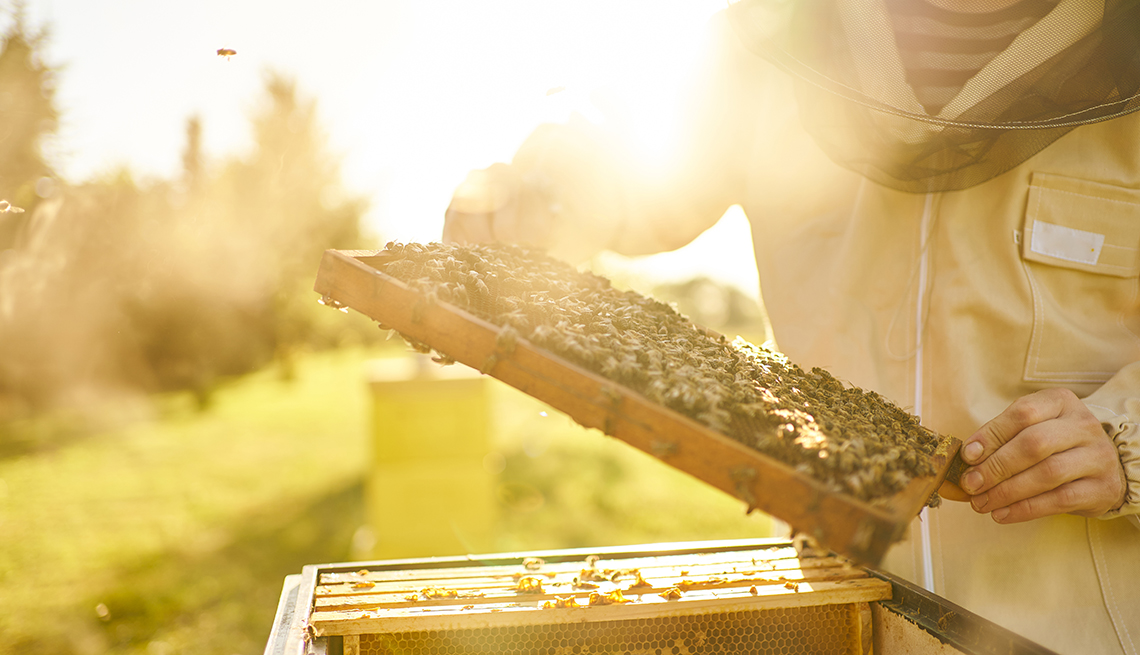
10 tips for first-time beekeepers
- Select a language for the TTS:
- UK English Female
- UK English Male
- US English Female
- US English Male
- Australian Female
- Australian Male
- Language selected: (auto detect) - EN
Play all audios:

4. YOU NEED SOME EQUIPMENT. You’ll see lots of videos of beekeepers casually pouring handfuls of bees into a hive with no glove or veil, or popping the top off a beehive with no protection.
They’re just showing off. I tried peeking into my hive with no gloves and was promptly chased across the yard by guard bees, the bouncers of the bee world. You’ll need a veil to cover your
face, because bees tend to attack areas with lots of carbon dioxide — like your nose, for example. Wear long sleeves and protective gloves when opening your hives. (Bees can sting through
fabric.) A smoker is also essential: Smoke calms bees and keeps them from chasing you across the yard when you open the hive. 5. YOU NEED TO INSPECT THE HIVE PERIODICALLY. The queen bee is
the number 1 consideration of the hive, and it should be for you too. Although bees will raise a new queen when the old one dies, a hive that’s not “queenright” will be more aggressive and
could be weakened enough not to survive the winter. You don’t need to inspect often (once or twice a month in good weather is fine), and never when the temperature is below 40 degrees. The
queen is hard to spot: She’s larger than the average bee, but so are drones, the generally indolent males in the hive. (All the other bees are female.) You can, however, spot the eggs she
lays and the larvae that the worker bees raise. Plenty of eggs and larvae means there’s probably a healthy queen. This is where YouTube videos are particularly helpful. Just don’t try it
without a veil and gloves. Be particularly careful when you’re inspecting the hive: Go slowly, be calm, and don’t make any loud noises. And don’t squash them. Bees have a pheromone they
emit when they are hurt or alarmed, which brings other bees buzzing to their rescue. You don’t want that. 6. THEY HAVE THEIR MOODS AND PET PEEVES. Just like humans, bees get cranky during
long stretches of hot, humid and rainy weather. They are sluggish in cold weather, and during hot, sunny days they sometimes congregate on the outside of the hive, which can be an alarming
sight. They’re just cooling off. Bees are particularly sensitive to smell. They know where their hive is — and who their friends are — because they recognize the scent of the queen’s
pheromone, which is basically a molecule with a scent. They don’t like other things with strong smells — such as bears, or your T-shirt after mowing the lawn on a hot day. The scent of
almonds repels them. They hate the smell of bananas, so lay off the banana bread before you visit the hive. And they love the smell of lemons, which can be problematic if you’re fond of
sipping lemonade on the patio. 7. YOU HAVE TO FEED THEM. You don’t have to put out 10,000 tiny honey dishes in the morning. But when you first get your hive, you’ll need to feed them. They
will need time to scout out their new territory — bees can range three miles or so — and, if you buy package bees, to start building new honeycomb. You also need to fatten them up in the
fall, so they can survive through the winter.
